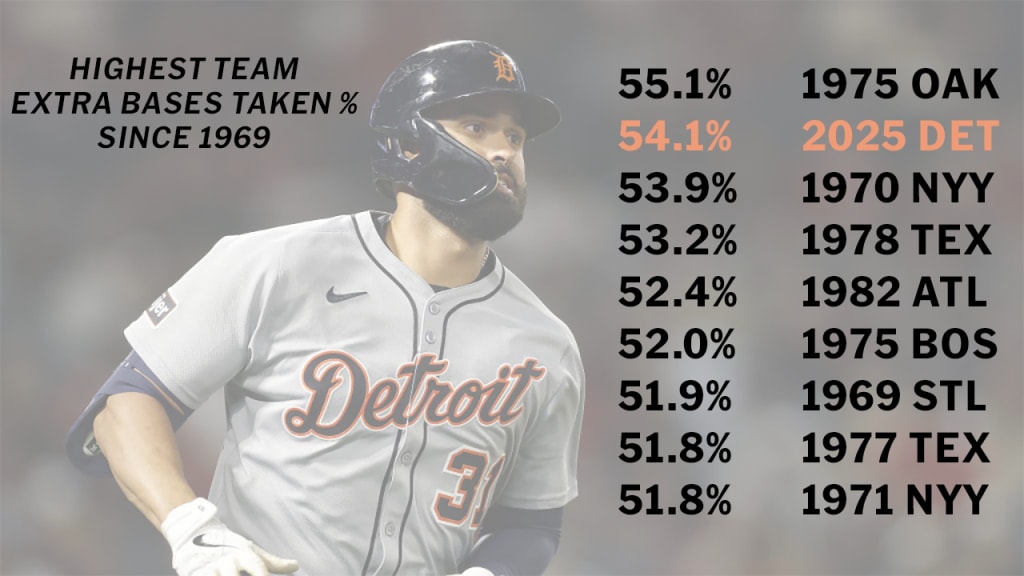It? It, in this case, is being aggressive on the bases, which was a big part of their surprising late-2024 surge to the playoffs, ramping up mostly after an “intense” pregame meeting led by Cora before an early-August series in Seattle.
Manager A.J. Hinch said as much in December, looking back.
“If you look at our season as a whole,” he said, “it will not tell the whole story of who we are. If you look at the beginning part of the season, we didn't put a ton of pressure on teams. We didn't run the bases quite as aggressively. We did mix and match quite a bit. The second half of the season, we got younger, we got more athletic.”
Quite right. It was “pitching chaos,” sure, but it was also action on the bases. We figured that would carry over into 2025, because Greene explicitly told us it would, as did infielder Gleyber Torres, who signed a one-year deal with the Tigers in December, and who later described a conversation he’d had with his new third-base coach shortly thereafter.
“When I got a phone call with Cora [after signing],” Torres said, ”he told me to be ready for running, because we’re running a lot.”
“A lot” might understate it by, well, a lot. We knew what they were planning to do, but they’ve accomplished that and then some: How about the second-most base-running-est team in the nearly six decades since the divisional era began in 1969?

That’s the rate of extra bases taken, and it’s exactly what it sounds like: It’s how often you’re successfully going first-to-third or first-to-home on a single, or scoring from first on a double, or going second-to-home on a single. It’s taking more than one base in a situation where the batter behind you isn’t forcing you to do so.
It’s this, basically. It’s Trey Sweeney scoring from first on a double.
It’s Javier Báez scoring from second on a single to a Gold Glove right fielder.
The Tigers’ rate of extra bases taken is by far the highest of the 2025 season – the second-place Brewers are well behind at 48%, and the Major League average is just 42% – and setting aside anything from the shortened 2020 season, as we’ve done, it’s the highest extra bases taken rate the Majors have seen since the speed-happy days of the 1970s and early 1980s. (This and all stats below are through Monday's games.)
(Those mid-70s A’s? The same ones who famously employed Herb Washington, a world-record sprinter, as a “designated runner.” Washington got into 110 games for the 1974-75 A’s, including the playoffs, without taking a single plate appearance or ever wearing a fielding glove.)
Surprisingly, this is not about stolen bases. The Tigers, incredibly, rank last in MLB, with just 28, having attempted only 34 swipes – or fewer than Tampa Bay infielder José Caballero has tried on his own. It’s not about elite team speed, either; the Tigers as a group are essentially league-average in Sprint Speed, tied for 17th, and their fastest player, outfielder Parker Meadows, is the slowest “fastest player on the team” of any team in the Majors.
It’s more about running the bases aggressively on batted balls where the Tigers rank at or near the top of the Majors in each of several categories.
- Going first-to-third or home on a single (61, most)
- Going first-to-home on a double (26, most)
- Going second-to-home on a single (66, most)
That’s going to inevitably lead to some outs, and indeed the Tigers have made 28 outs on the bases, the fourth-most in the game. On the other hand, that’s partially about having runners on base to be thrown out in the first place; you’d surely rather have the offenses of the Rays, Phillies, and Padres (the three teams with most outs on the bases) than the Rockies, Astros, and Angels (the three teams with the fewest).
It’s not even really about having taken the most bases overall, because they haven’t. (That would be the Dodgers, in no small part because no team gets more runners on base in the first place.) It’s about trying the most often, really, like when Kerry Carpenter went first-to-third in April against the Royals and the strong-armed Hunter Renfroe, who was then their right fielder.
In that particular situation – two-out single with a runner on first base, thus presenting a choice to stay at second or go to third – the Tigers have made an attempt to advance 75% of the time, easily the most in baseball. (The Padres, at 61%, are in second place. At the bottom, the Pirates have done so just 20% of the time.) With less than two outs, the Tigers are second only to the Marlins in aggressiveness.
It’s the same thing with a runner on second with less than two outs, where a single is hit and the runner has the chance to stay at third or be waved home. Seventy-two percent of the time, Cora is waving the runner in; no team does it more.
It’s also not about the batter taking extra bases, because that particular metric is just about the baserunner. But surely, things like Zach McKinstry hustling out a double against one of the strongest-armed outfielders in the Majors (Baltimore’s Ramón Laureano) counts, too, right?
That’s what Statcast’s version attempts to account for, including not only the batter stretching singles into doubles and doubles into triples but also comparing to what the average rates in those situations are, based on runner speed, outfielder throwing arm, and position of both players on the field. That version goes back to 2016, including the batter and the runners, and setting aside the shortened 2020 again, we can tell you this:
Again, sometimes it doesn’t work. Sometimes Torres will try to stretch a single into a double and get thrown out, as he did in May on the most damaging (from a run value perspective) try of the Detroit season, and those are the ones people remember. It’s not close to the most important reason for Detroit’s success, because adding six runs via baserunning aggressiveness (second to Milwaukee) is a relatively modest figure, compared to batting (where they’ve added +29 runs of value) or pitching (where they’ve added +25 runs).
But it adds pressure, to be sure, and excitement, and it certainly makes for a good team identity when you’re doing something no team has done since 1975.
“It gets the boys going, too,” said Greene. “It’s momentum.”
“I don’t really care about safe or out,” said Hinch in spring, “as much as we do the identity: 'This is how we play.'”
It sure seems to be. It’s exactly what they told us they’d be doing. The data says that they’re more than backing it up.
Thanks to Kenny Jackelin of Baseball-Reference for research assistance.
